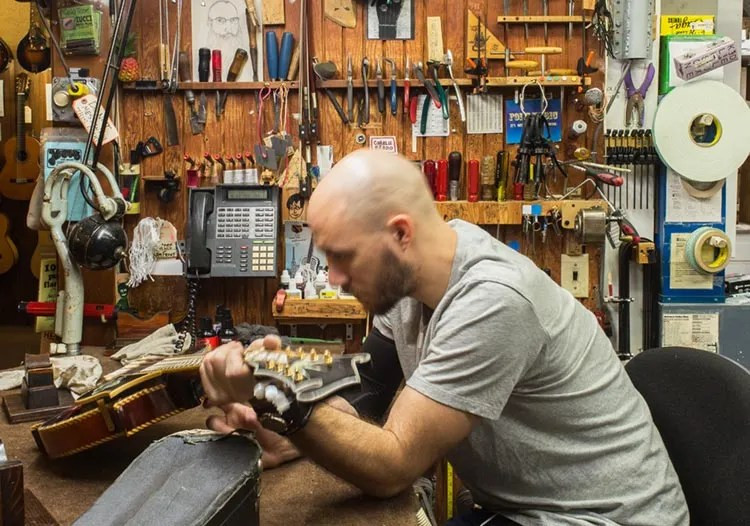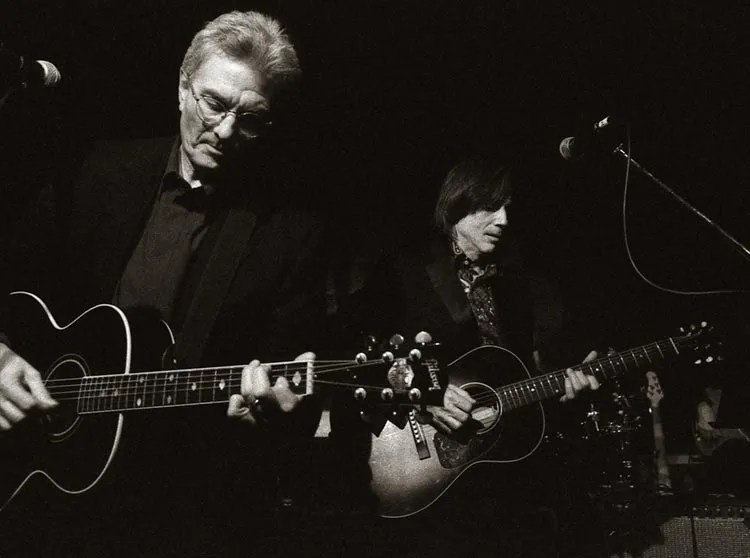Stepping into McCabe’s Guitar Shop at 3101 Pico Blvd., Santa Monica, is like entering a different world. Leaving behind the typical Los Angeles strip malls, you’re greeted by a unique space that feels more like a scene from a Wes Anderson movie than just a music store. The guitar-neck door handle is just the first hint of the extraordinary experience within.
Inside McCabe’s, a playful mechanical cobbler diligently works in its plexiglass enclosure, positioned across from an antique cash register. A replica of an Apatosaurus dinosaur head oversees the scene, and a repurposed traffic light cycles through its colors. The aroma of complimentary coffee fills the air, and a whiteboard announces diverse classes like Mali Fingerstyle Guitar and Indian Slide Guitar, showcasing the shop’s eclectic spirit.
The shop is alive with a gentle energy. A young musician creates delicate arpeggios on a Celtic harp, while a child, barely big enough for a parlor guitar, practices chords. In the open repair area, Matt Bradford, a skilled guitar technician, focuses intently on restoring a vintage Gibson archtop. Staff members engage warmly with customers, and a German radio crew prepares for a live broadcast, adding to the vibrant atmosphere of McCabe’s Guitar Shop.
Bob Riskin, the longtime owner, observes the bustling scene with a thoughtful expression, joined by his wife and co-owner, Espie Riskin. After a warm welcome, they guide visitors to the private room, a space adorned with redwood panels and filled with banjos and Taylor guitars, revealing the depth and breadth of McCabe’s offerings.
 Bob and Espie Riskin, owners of McCabe's Guitar Shop
Bob and Espie Riskin, owners of McCabe's Guitar Shop
A Rich History Rooted in the Folk Era
McCabe’s Guitar Shop isn’t just any music store; it’s a landmark. LA Weekly even created a humorous award category, “Best Guitar Shop (That’s Not McCabe’s),” highlighting its legendary status. More than a store, McCabe’s is a celebrated acoustic music venue, a respected music school, and a vital community hub on the West Coast. It’s truly unique.
The story of McCabe’s began with Gerald McCabe, a furniture designer who found his way into the music world through his first wife, folksinger Marsha Berman, in the mid-1950s. His woodworking skills led to instrument repair requests, and in 1958, he opened a small shop near its current location, catering to the growing folk and roots music scene. He brought in ethnomusicologist Ed Kahn to manage books and records and mentored Walter Camp in guitar repair. This marked the humble beginnings of what would become a beloved institution for “mccabe’s guitar” enthusiasts and musicians alike.
Bob Riskin, son of film director Robert Riskin and actress Fay Wray, grew up near McCabe’s in West Los Angeles. He first visited in 1959 at age 16. “It was the only guitar store in LA then, and quite empty except for Walter Camp,” Bob recalls, his voice resonating like the banjos surrounding him.
Bob had just acquired his first guitar, a 1912 Martin needing repair. He became a regular at McCabe’s, eventually working there, starting with sweeping and errands before learning guitar repair. His Martin became his first repair project. “It was badly damaged, and I learned to fix it piece by piece,” Bob explains. “Then I learned other skills, like hand-scraping rosewood, and I never left.”
McCabe’s fostered a community atmosphere with a coffee pot and seating, attracting local and traveling musicians. A young Ry Cooder was an early devotee. “He was only 14, and we already admired him. He was a musical sponge—he could instantly play back anything you played,” Bob says.
“And better!” Espie Riskin adds with a smile.
“That’s when I knew I wasn’t going to be a musician,” Bob jokes.
 Bob and Espie Riskin, owners of McCabe's Guitar Shop
Bob and Espie Riskin, owners of McCabe's Guitar Shop
Innovations in Guitar Repair and Design
In the early days, Bob and his colleagues had to invent repair techniques as resources were scarce. Their experimentation led to the creation of many common guitar accessories. “We invented countless things, many still used today—like string winders, which I used to hand-build,” Bob mentions. “I even made great picks from cheese, but that’s another story.”
Responding to musical trends, McCabe’s also modified instruments in ways now considered unconventional, influencing major guitar manufacturers. The Rooftop Singers’ 1963 hit “Walk Right In” increased demand for 12-string guitars. With few available, McCabe’s converted six-string Martin 00-21s, known for their wide necks. “It was intricate work. We extended the pegheads, perfectly matching everything, and changed the bridges. They were fantastic, beautiful-sounding guitars,” Bob recounts, noting Martin soon offered their own 12-strings. This innovative spirit is a hallmark of McCabe’s guitar history.
McCabe’s thrived in the guitar boom of the early to mid-1960s. In 1964, the shop moved to 3103 Pico, outgrowing its original space. That year was also significant for Bob personally.
“I met my wife here,” he says fondly.
“He sold me my first guitar,” Espie adds, recalling her Mexican Amezcua Guitarra from Paracho.
She was the only customer when McCabe asked her to watch the shop while he photographed furniture. “He said, ‘Here’s the register—I’ll be right back.’ Luckily, Bob walked in. And I never left,” Espie laughs, who now manages the shop’s operations after a biotech career.
“It’s true, and I got your name wrong—I just made one up,” Bob chuckles. Espie still owns that first Amezcua guitar, a testament to their enduring connection to McCabe’s.
The Accidental Concert Venue
In 1969, another fortunate event transformed McCabe’s. Folk-blues guitarist Elizabeth Cotten was stranded in LA after a cancelled gig. To help her return home, McCabe’s offered her a performance space, despite not having a stage. “We improvised a stage for her,” Bob remembers. “We hung curtains—or maybe plastic bags—on the window and used our teaching chairs for the audience. She gave an amazing show.”
This successful concert, and the realization that concerts would necessitate regular shop cleanups, led McCabe’s to host weekly performances. The intimate venue now accommodates 150 people. The first official concert featured Bryndle, a local band, with a young Jackson Browne opening. “After that, we never needed to go past La Cienega,” Bob says, referring to West Hollywood folk clubs.
For over five decades, countless artists have graced the McCabe’s stage. Singer-songwriters like Richard Thompson and Joni Mitchell have used it as a creative space. Guitar legends such as Doc Watson, Merle Travis, Eric Clapton, Chet Atkins, Norman Blake, John Hammond Jr., David Lindley, and John Fahey have performed, alongside jazz innovators like Sun Ra, Don Cherry, and Charlie Haden. R.E.M. played at McCabe’s in 1987 at their peak, and Beck and Liz Phair performed in the 90s. The legacy of “mccabe’s guitar” and its stage is undeniable.
Singer-songwriter David Wilcox, known for his guitar skills, reflects, “I’ve played McCabe’s on my way up and down. The store’s concert tradition is so long and fascinating; being part of it is a lesson in mortality.”
To preserve this legacy, thousands of McCabe’s concert recordings have been donated to the University of North Carolina at Chapel Hill’s Southern Folklife Collection. “They’re digitizing them before the tapes degrade,” Bob explains.
“I had to catalog them all, one by one,” Espie adds, describing her labor of love.
 Jackson Browne at a Grammy after-party
Jackson Browne at a Grammy after-party
Folding Chairs and String Reverb: The McCabe’s Ambiance
Bob became a part owner of McCabe’s in 1969. Around 1972, he undertook a significant project, moving McCabe’s to its current, larger location at 3101 Pico Blvd. This two-story, 6,000-square-foot space, four times bigger than the previous shop, became the McCabe’s we know today.
Bob, who became the sole owner in 1986 when McCabe sold his share, states, “I designed much of it. I influenced almost everything you see: the layout, walls, everything.” Pointing to the redwood paneling in the private room, he adds, “This redwood design—it’s like everyone’s high-end room now. People photographed it years ago, and suddenly, [wooden wall treatments] appeared in every Guitar Center and Best Buy high-end room.” Bob’s design aesthetic has become synonymous with the “mccabe’s guitar” experience.
A glass case in the main room displays high-end guitars, including a Froggy Bottom parlor and a Martin Custom Shop 00. Nearby, Adirondack-topped dreadnoughts from Collings are featured. High-end ukuleles and mandolins line the walls near the ceiling, and instruments of all types and prices, including a Wazoo kazoo and a sarod, are scattered throughout. “We serve everyone from kids to pros, with a big middle range,” Bob says.
Aside from unique items like a non-sale Gibson Style-U harp guitar above the entrance, vintage guitars are notably scarce. Bob explains pragmatically, “We’re in a golden age of guitar building. Today’s guitars are far superior to those from the ’50s, ’60s, ’70s, or ’80s. Standards are incredibly high now. ‘Imported’ used to mean low quality, but now fantastic instruments come from overseas factories, and there are many brilliant independent luthiers.” This focus on quality over vintage is a key aspect of McCabe’s philosophy.
 Jackson Browne at a Grammy after-party
Jackson Browne at a Grammy after-party
Walking through a hallway filled with ukuleles and student violins, Bob leads to the back room concert space. Walls are lined with instruments, from electric guitars to resonators. Stacks of folding chairs are neatly arranged outside the sound room. “These are the best folding chairs you can find,” Bob jokes about the venue’s seating.
The back room’s famously uncomfortable chairs are compensated by its exceptional acoustics. Sound engineers originally designed the space. An unexpected benefit of being both a venue and showroom is the sympathetic resonance from displayed instruments, adding a natural reverb effect. Wilcox playfully calls it “string reverb,” another unique characteristic of the “mccabe’s guitar” concert experience.
Upstairs are lesson rooms and offices, with hallways decorated with black-and-white photos of past performers. “Seeing those photos is fascinating and humbling,” Wilcox reflects. “It feels like a pilgrimage, realizing how many have been there before.”
McCabe’s currently has over two dozen music teachers. A glimpse into a classroom reveals a blackboard diagramming a 12-bar blues progression and shelves filled with guitar cases.
“Many who buy their first guitars here also take lessons at McCabe’s, and some even become teachers here,” Bob notes, highlighting the shop’s cyclical community involvement.
In concert director Lincoln Myerson’s office, Brian Rodriguez, a young employee, works at a computer. A Stella guitar and Oscar Schmidt autoharp lean against the wall.
“I got my first guitar here and have been coming back ever since,” Rodriguez shares, echoing a common sentiment at McCabe’s.
[Editor’s note: Walter Camp, a McCabe’s founder, recently passed away. Bob Riskin wrote on the McCabe’s website, “Walter was a thinker and a visionary. We created a place for patrons to gather, share music, get repairs, lessons, instruments, and coffee. The heart of his beloved guitar shop was shaped during his decade here (1960-70). My happiest times were working with Walter.”]
For anyone passionate about “mccabe’s guitar” and music, a visit to McCabe’s Guitar Shop is more than a shopping trip; it’s an immersion into a rich history and a vibrant community.
